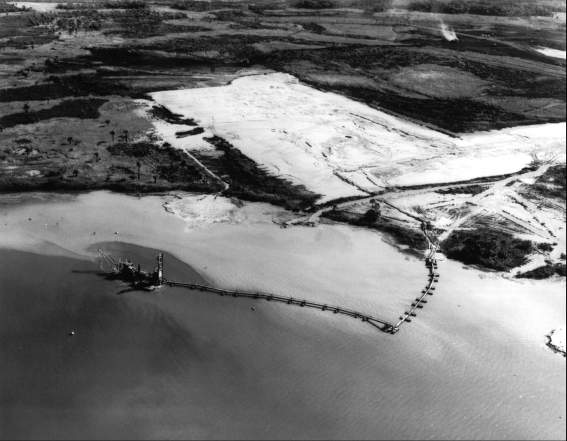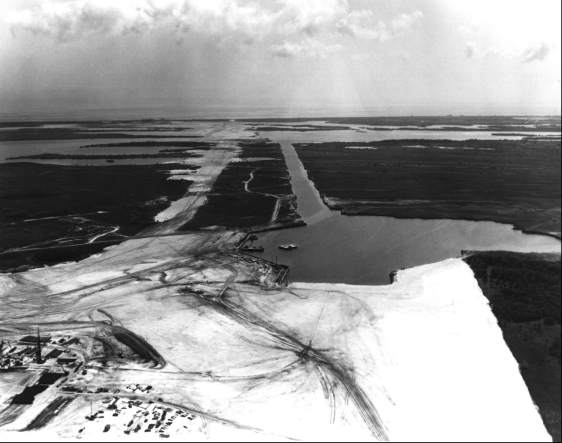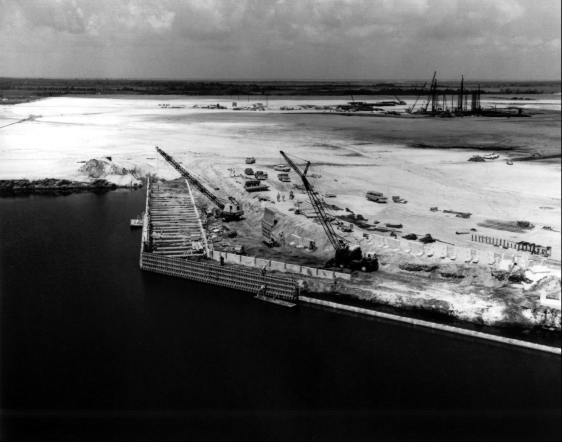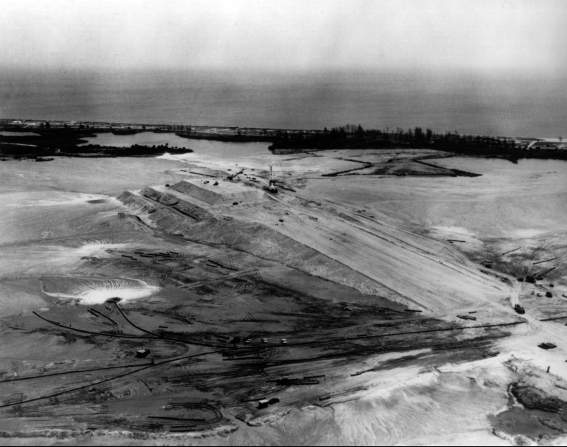
Before thousands of skilled craftsmen could begin turning these unique designs into structures, the Launch Operations Center had to prepare the sites, dredge access channels, and fight mosquitoes. The Gahagan Dredging Corporation of Tampa won the contract to clear the land and dredge an access channel to the site of the vertical, or as it was soon to be called, the vehicle assembly building (VAB). The sand, dredged up by the Gahagan crews, was deposited on the projected sites of the VAB, the crawlerway, launch pad 39-C (shortly to be redesignated pad A*, and the causeway over the Banana River.

Dredging hydraulic fill from the Banana River and pumping it onto a construction site, December 1962. The water is draining back into the river above and right of the barge.
Gahagan started work on 31 October 1962 by clearing the land in the VAB area. Dredging began a week later. By the time the contract was awarded, Gahagan had three dredges at work and had already moved 20,600 cubic meters of fill. One part of the work involved the clearing of surface growth, ranging from palmetto scrub to orange trees, and the stripping away of undesirable surface material from the construction sites. Specialized equipment helped to speed this job. One device, a palmetto plow, pulled up trees by their roots, shook off the dirt, and piled them for burning. Bulldozers with heavy teeth on the blades knocked down whole rows of trees and brush, pushing them into piles to dry before burning. The bulldozers cleared some 2.5 square kilometers of land in this manner, while other earthmoving equipment removed 894,400 cubic meters of soft sand and muck.1

The barge canal and turning basin, with assembly building site in lower left, August 1963.

The wharf under construction at the turning basin, with assembly building site in background, August 1963.
The second, and perhaps larger, part of Gahagan's job was dredging a barge canal 38 meters wide, 3 meters deep, and 20 kilometers long from the original Saturn barge channel in the Banana River to a turning basin near the VAB. The canal would serve barges bringing in the first and second stages of the Saturn V. Gahagan dredged a channel to pad A so that barges could deliver material directly to the LC-39 construction site.
During the dredging operations, the powerful hydraulic pumps coughed up 6,876,000 cubic meters of sand and shell for fill. A major portion of it went into the 57-meter-wide, 2-meter-high crawlerway, which would stretch more than 4.8 kilometers from the VAB to pad A.

One of the big sandpiles: hydraulic fill piled on the site of LC-39, pad A, June 1963.
Out at the pad site, the pumps piled a pyramid of sand and shell 24.4 meters high, one of the highest recorded pumping operations. All the while, draglines, bulldozers, and other earth-moving equipment molded the mound into the approximate shape of the launch pad. Subsequent measurements revealed that this outsized sandpile had settled 1.2 meters and properly compressed the soil beneath. Bulldozers then removed part of the pile to bring the fill to the proper elevation.2
A final inspection of the land clearing, channel dredging, and fill in early September 1963 showed that Gahagan had completed all work on the contract. About six months after the completion of the fill for pad A, Gahagan began pumping and piling hydraulic fill for launch pad B and for the causeway from Cape Canaveral to Merritt Island east of the industrial area.3
* At the time of the original siting of launch complex 39, the three projected launch pads were designated in accordance with standard Missile Test Center practice from north to south as pads A, B, and C. In January 1963, to bring the identification system in line with construction and operational use schedules, the pad designations were reversed, the southernmost becoming pad A. Early documentation carries the original designations; the revised designations are used hereafter in the text. C. Bidgood, Chief, Facilities Off., "Reidentification of Launch Complex 39 Launch Pads," 7 Jan. 1963.


